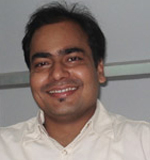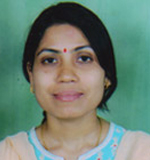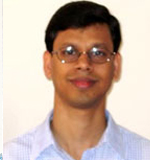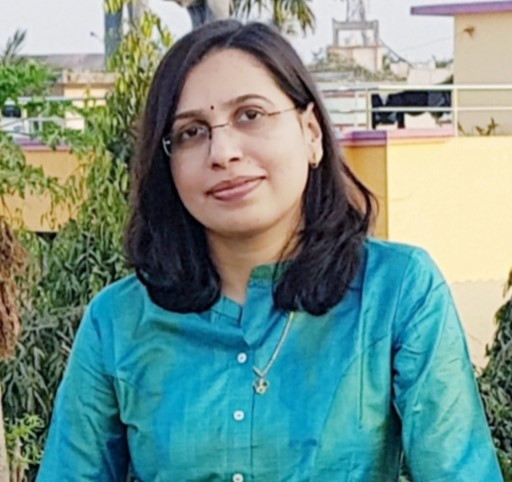Head of the School
 |
|
674-713-5136
hos.sbs@iitbbs.ac.in |
Chemistry
|
Mathematics
|
Thrust Areas in Biophysical Chemistry, Biochemistry and Microbiology (i) Protein Chemistry & Spectroscopy, Structure-Function Elucidation of Various mycobacterial and mammalian Small Heat Shock Proteins, virulence and pathogenesis of Mycobacterium Tuberculosis, exploration of therapeutic potential of peptides, Investigation of Amyloid Fibrillation and their significance in preventing different amyloid diseases
Thrust Areas in Cancer Biology (i) Role of AAA+ ATPases in cancer (ii) Cancer drug discovery (iii) Gastrointestinal (gastic/stomach, pancreatic and colorectal) cancers and gut microbiota (iv) Role of probiotics as biotherapeutics for colorectal cancer prevention
Thrust Areas in Chemical and Molecular Biology (i) Structure function studies on peptide or protein binding G-protein Coupled Receptors, Molecular and Cellular Biology (ii) Rational Design of Peptide / Protein as Therapeutics (Antimicrobial / Antiviral / Anti-inflammatory) (iii) Computational Biology and Bioinformatics
Thrust Areas in Biochemistry and Biophysical Chemistry (i) Protein Chemistry & Spectroscopy, Structure-Function Elucidation of Various Small Heat Shock Proteins Related to Different Diseases (Cataract, Leprosy and Tuberculosis). (ii) AAA+ATPase, Screening and validation of Antibacterial and Anticancer drugs
Thrust Areas in Inorganic Chemistry(i) Synthesis and Coordination Aspects of Homo and Heterometallic Complexes; Metal Based Anticancer/Imaging Agents; Functional Materials and Luminescent Materials; Nanoparticle Based Sensors. (ii) Coordination Chemistry with an application of magnetic materials, Supramolecular assembly, MRI contrast agents, Fluorescent Chemosensors for biological molecules, ions, hazardous chemicals and explosives.
Ionic liquids as electrolytes for Lithium Ion Batteries
Thrust Areas in Organic Chemistry (i) Heterocyclic Chemistry, Asymmetric synthesis using chiral pool approach; Enantioselective catalysis and new reaction methods; New molecular entities with biological properties; Dipolar Cycloadditions; C-H functionalization, Pericyclic reactions, Metathesis, Umpolung chemistry, Radical chemistry, traditional & newer functional group transformations for application in marine alkaloids synthesis, terpenoids and polyketide based natural products, Anticancer and Antimicrobial activities of plant-derived natural products. (ii) Carbohydrate Chemistry, novel synthetic methods development, Bioactive Natural and Unnatural Products synthesis (iii) Supramolecular Chemistry, Molecular Recognition through Solid State; Metal- Organic and Covalent Open Frame (MOF and COF) Compounds. (iv) Polymer chemistry: Synthesis of Chiral Polymers and their applications in chiral induction; Synthesis of Achiral and Chiral Resins and their applications in synthesis; PIL stabilized metal nanoparticles and their applications; Polyelectrolyte-DNA interaction studies; PILs for gas separation membranes; Synthesis of MIPs and resins for nuclear waste treatment; Synthesis of (RAFT derived) ionic, pH, temperature and solvent responsive homo- and block copolymers towards their self-assembling for drug delivery. (v) Design, Synthesis and Characterization of Peptides using CD, Fluorescence, ITC and NMR. Redesigning known drugs for other Therapeutic applications. (vi) Enabling technologies for organic synthesis: Photocatalysis, Synthetic organic electrochemistry, Photoelectrochemistry, Transition metal catalysis, flow chemistry. (vii) Hydrogels, nanocatalysts and electrodes for water splitting and other electrochemical reactions, responsive polymer networks, self healing and shape memory polymers, development of solid electrolytes and flexible electronics devices, batteries and actuators
Thrust Areas in Physical, Theoretical and Computational Chemistry (i) Time-resolved spectroscopy on molecules and materials: Developing spectroscopic tools and photomaterials; Harvesting triplets from Singlet fission; Photophysics of thermally activated delayed fluorescence; Long- range charge separation in emerging photomaterials. (ii) Molecular modelling; Molecular Dynamics (MD) simulations. (iii) Development and application of multi-configurational Quantum Mechanical Methods to study energetics and dynamics of bound and transient states; Investigation of photochemical reactions in the non-adiabatic ("beyond-Born- Oppenheimer") realm; Computational modelling of chemical reactions using quantum mechanical (QM) and mixed quantum mechanical - molecular mechanical (QM/MM) methods; Investigation of bacterial resistance toward beta-lactam based antibiotic drugs using QM/MM methods.
Thrust Areas:
(i) Accelerator based atomic, molecular and surface physics: Experimental Atomic-Molecular-Surface Physics, Molecular Electronics, Scanning Tunnelling Microscopy, nanomaterial, Biomolecules, Ion beam engineered quantum materials for energy and sensing applications, Design and fabrication of Accelerator based systems, Applications of energetic ion beam in atomic, molecular and surface phenomena, Synchrotron radiation based research, High energy charged particles use and associated instrumentation developments, Structural application, modification of materials and health/medical applications.
(ii) Atomistic Modeling and Molecular Simulations: Large Scale Quantum Simulations of Nanostructures, Quantum Transport in Graphene and 2- Dimensional layered Structures, Quantum Mechanics and Molecular Mechanics, Modeling of Biological Systems, Biophysics, Energy Materials, Magnetic Materials, Materials Modeling using Machine Learning.
(iii) Experimental Condensed Matter Physics: (a) Surface and Interface Physics: Growth, modification, novel applications, and related fundamental and applied physics aspects leading to Quantum devices and technology. This includes microscopy methods (use and development of novel methods), such as SEM, TEM, AFM, STM, Small angle X-Ray, XRD, Raman, UV- Vis,), Synchrotron Radiation Research, Ion beam applications (b) Strongly Correlated Electron Systems: High-temperature Superconductor, Multiferroics, and magnetoelectrics, topological phases of matter; Magnetism at the nanoscale, Anomalous Hall Effect in quantum materials, Bio Magnetism, 2D dilute magnetic semiconductors (c) Materials growth related to Energy, Quantum technology, and Strategic areas. (d) Device Physics: Fabrication, testing, and prototyping of low- dimensional, nanostructural, and quantum phenomena-based devices, Semiconductor Quantum Qubits and associated electronics, the mechanical design of novel devices, Energy storage materials and devices, Flexible and Stretchable Devices, Biosensors, Neuromorphic devices and networks, photovoltaic and solar cell device, Light Emitting Devices (e) Energy storage materials and devices, Flexible and Stretchable Devices, Biosensors, Neuromorphic devices and networks, 2D materials, TMDs, and heterostructures. (f) Soft condensed Matter, 2D dilute magnetic semiconductor, photovoltaic and solar cell device, Light Emitting Devices, Bio Magnetism. (g) Semiconductor Fabrication: Wide band gap semiconductors (like SiC), growth and characterization of Epilayers on SiC (and other WBG), Sensors and Detectors for harsh environments (h) Instrumentation: Devices/Sensors/Detectors fabrication, testing and packaging (i) Experimental High Energy Physics: Rare B and charm decays (j) Nanophotonics and Plasmonics: Coupling Photonic nanostructures to Nano waveguides and resonators; Semi-Classical and Quantum Interferometers; Structured Light; Flexible and Wearable Photonics; Instrumentation for Industrial Applications; Agriphotonics; Optical Devices; Biosensing
(iv) Theoretical Condensed Matter Physics/Statistical Mechanics: Quantum Dissipation & Decoherence, Open quantum system, Quantum Transport, Non-equilibrium Phenomena like the study of first passage properties (Classical & Quantum ), persistence and related topics, Topological Order, Integrable systems
(v) Theoretical High Energy Physics: Classical and Quantum Gravity, Mathematical Physics, String Theory, Black Hole Thermodynamics and Phase transitions, AdS/CFT Correspondence, Quantum Field Theory, gauge theory, Mathematical aspect of QCD
(vi) Computational soft matter and biophysics: Phase transitions and critical phenomena, Domain coarsening in passive and active matter systems; Aging dynamics in out-of-equilibrium systems; Transport of intelligent active matter through complex geometries; Cellular uptake of hard and deformable nanoparticles; Interaction and self-assembly of nanoparticles at bio-membranes, Phase behavior and wetting phenomena of flexible and semiflexible polymers; Structural, mechanical, and transport properties of nano-composite (polymer-grafted nanoparticle) systems; Evaporation induced self-assembly.
Complex Analysis, Complex Dynamics and Fractals, Functional Analysis, Virational inequalities, Complementarity problems, Algebra, Combinatorial Matrix Theory, Spectral Graph Theory, Data mining, and Portfolio Analysis, Soft Computing, Optimization Theory, Numerical Analysis, Fluid Dynamics, Bio-fluid dynamics, Computational Fluid dynamics, Numerical Methods for PDEs, Probability Theory and Random Matrix Theory, Queueing Theory, Stochastic Models, Applied Probability, Control of Queues. Number Theory, Stochastic Partial Differential Equations.
Stochastic Control Problems, Numerical Solutions to PDEs, Applied Nonlinear Analysis, Several Complex Variables, Valuation Theory, Algebraic Geometry, Commutative Algebra, Combinatorial Commutative Algebra, Number Theory, Control Theory, Linear Algebra, Stochastic Differential Equations (Theory and Numerical), Random Matrix Theory, Operator Theory.




